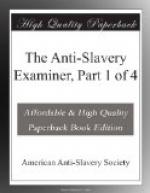[Footnote A: The French language in this respect follows the same analogy. Our word grandson being in French, petit fils, (little son.)]
Even if the Africans were the descendants of Canaan, the assumption that their enslavement is a fulfilment of this prophecy, lacks even plausibility, for, only a mere fraction of the inhabitants of Africa have at any one time been the slaves of other nations. If the objector say in reply, that a large majority of the Africans have always been slaves at home, we answer, 1st. It is false in point of fact, though zealously bruited often to serve a turn. 2d. If it were true, how does it help the argument? The prophecy was, “Cursed be Canaan; a servant of servants shall he be unto his brethren” not unto himself!
OBJECTION II.—“If a man smite his servant or his maid with a rod, and he die under his hand, he shall surely be punished. Notwithstanding, if he continue a day or two, he shall not be punished, for he is his money.” Exodus xxi. 20, 21.
Arguments drawn from the Mosaic system in support of slavery, originate in a misconception both of its genius, as a whole, and of the design and scope of its most simple provisions. The verses quoted above, afford an illustration in point.
What was the design of this regulation? Was it to grant masters an indulgence to beat servants with impunity? and an assurance, that if they beat them to death, the offence would not be capital? This is substantially what some modern Doctors tell us. What Deity do such men worship? Some blood-gorged Moloch, enthroned on human hecatombs, and snuffing carnage for incense? Did He who thundered out from Sinai’s flames, “THOU SHALT NOT KILL,” offer a bounty on murder? Whoever analyzes the Mosaic system—the condition of the people for whom it was made—their inexperience in government—ignorance of judicial proceedings—laws of evidence, &c., will find a moot court in session, trying law points—setting definitions, or laying down rules of evidence, in almost every chapter. Numbers xxxv. 10-22; Deuteronomy xi. 11, and xix. 4-6; Leviticus xxiv. 19-22; Exodus, xxi. 18, 19, are a few, out of many cases stated, with tests furnished by which to detect the intent, in actions brought before them. The detail gone into, in the verses quoted, is manifestly to enable the judges to get at the motive of the action, and find out whether the master designed to kill.
1. “If a man smite his servant with a rod.”—The instrument used, gives a clue to the intent. See Numbers xxxv. 16, 18. It was a rod, not an axe, nor a sword, nor a bludgeon, nor any other death-weapon—hence, from the kind of instrument, no design to kill would be inferred; for intent to kill would hardly have taken a rod for its weapon. But if the servant dies under his hand, then the unfitness of




